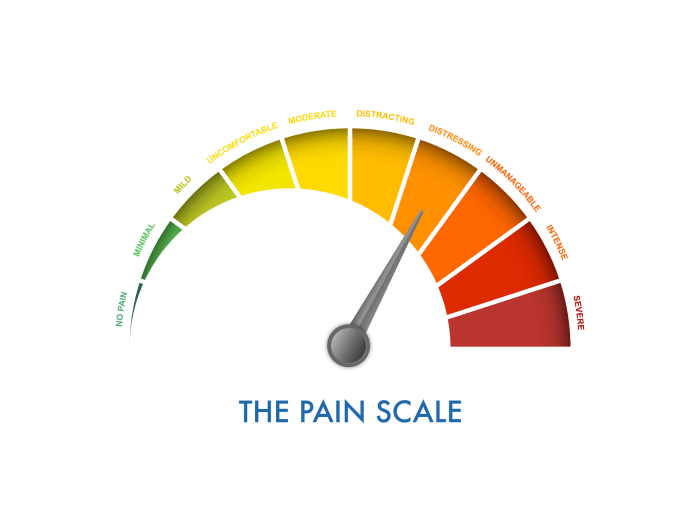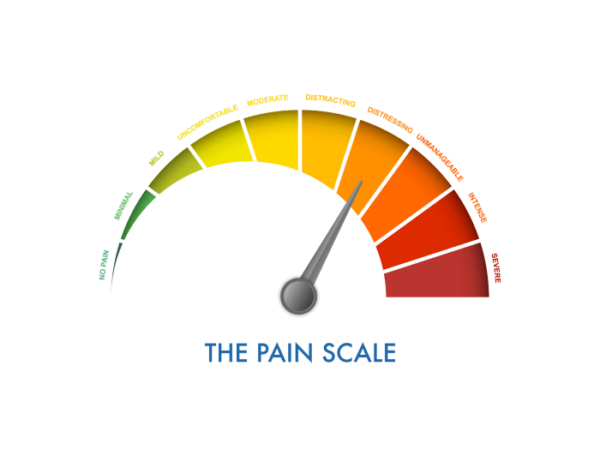
How do insurance companies calculate pain and suffering? It’s a question that pops up when you’re dealing with a personal injury claim, right? You’re hurting, physically and emotionally, and you want to know how much your suffering is worth. But insurance companies have their own methods for putting a price tag on your pain.
This article will dive into the murky world of pain and suffering calculations. We’ll explore the legal definition, the methods insurance companies use, the factors they consider, and the common approaches to determining a dollar amount. We’ll also shed light on the importance of evidence and documentation in supporting your claim. Buckle up, it’s gonna be a wild ride!
The Concept of Pain and Suffering
In the realm of personal injury law, “pain and suffering” is a crucial element that seeks to compensate victims for the non-economic damages they experience due to an injury. It’s a complex concept that goes beyond quantifiable medical expenses, encompassing the emotional and psychological toll that an accident or injury can inflict.
The Legal Definition of Pain and Suffering
Pain and suffering, in legal terms, refers to the subjective experience of physical discomfort, emotional distress, and mental anguish that arises from an injury. It’s not just about physical pain; it also encompasses the emotional and psychological impact of the injury on a person’s life. This can include:
- Physical pain: This includes the discomfort and suffering associated with the injury itself, such as chronic pain, headaches, and sleep disturbances.
- Emotional distress: This includes feelings of anxiety, depression, fear, and anger related to the injury and its consequences.
- Mental anguish: This encompasses the psychological toll of the injury, such as post-traumatic stress disorder (PTSD), loss of self-esteem, and difficulty concentrating.
The Subjective Nature of Pain and Suffering
Pain and suffering are inherently subjective experiences. What one person considers significant pain and suffering may be perceived differently by another. Factors that influence the severity of pain and suffering include:
- The nature and severity of the injury: More severe injuries generally result in greater pain and suffering. For example, a broken leg will likely cause more pain and suffering than a minor cut.
- The individual’s tolerance for pain: Some individuals have a higher pain tolerance than others, which can affect their perception of pain and suffering.
- Pre-existing conditions: Individuals with pre-existing conditions may experience greater pain and suffering from an injury. For example, someone with a pre-existing back condition may experience more severe pain from a car accident.
- The impact on daily life: The extent to which an injury disrupts a person’s daily life can also influence their pain and suffering. This includes things like lost wages, inability to participate in hobbies, and difficulty performing everyday tasks.
Factors Contributing to Pain and Suffering
The severity of pain and suffering is often influenced by a combination of factors. These can include:
- Physical injuries: The type, severity, and duration of physical injuries play a significant role in determining pain and suffering.
- Emotional distress: The emotional impact of the injury, such as fear, anxiety, and depression, can contribute to pain and suffering.
- Loss of enjoyment of life: Injuries can significantly impact a person’s ability to enjoy life, leading to feelings of frustration, isolation, and despair.
- Disfigurement: Injuries that result in disfigurement can lead to significant pain and suffering, especially in cases involving facial injuries or scarring.
- Loss of companionship: In cases where an injury prevents someone from engaging in social activities or spending time with loved ones, it can contribute to feelings of isolation and loneliness.
- Loss of income: The financial impact of an injury, such as lost wages and medical expenses, can contribute to stress and anxiety, further increasing pain and suffering.
Methods for Assessing Pain and Suffering

Insurance companies face the challenge of putting a monetary value on something as subjective and intangible as pain and suffering. To do this, they employ various methods, each with its strengths and weaknesses.
Methods for Assessing Pain and Suffering
Insurance companies use a variety of methods to assess pain and suffering, each with its own set of advantages and disadvantages. Here’s a breakdown of some common approaches:
| Method | Description | Advantages | Disadvantages |
|---|---|---|---|
| Analogous Case Method | This method involves comparing the current case to similar past cases with known settlements. The insurer uses past judgments and settlements as a guide to determine a fair amount for pain and suffering. | Provides a benchmark for settlement amounts, based on historical data. | May not accurately reflect the unique circumstances of the current case. Past settlements may not be entirely comparable. |
| Structured Settlement Method | In this method, the settlement is structured as a series of payments over time. This can be beneficial for claimants who need ongoing financial support, such as those with long-term disabilities. | Provides a predictable stream of income for claimants, potentially helping with long-term needs. | May be more complex to manage, and the present value of the settlement may be lower than a lump sum. |
| Multiplier Method | This method involves multiplying the claimant’s economic damages (e.g., medical bills, lost wages) by a factor to account for pain and suffering. The multiplier is typically determined based on the severity of the injury and the duration of the suffering. | Provides a relatively straightforward way to calculate pain and suffering, based on quantifiable economic damages. | Can be subjective and open to interpretation. The choice of multiplier can significantly impact the settlement amount. |
| Per Diem Method | This method assigns a daily value to pain and suffering, based on the severity and duration of the injury. The total amount is calculated by multiplying the daily rate by the number of days of suffering. | Provides a structured approach to valuing pain and suffering, considering both severity and duration. | May not accurately capture the full extent of suffering, especially for long-term injuries or conditions. |
Challenges in Quantifying Pain and Suffering
While various methods exist, accurately quantifying pain and suffering remains a significant challenge.
* Subjectivity: Pain and suffering are highly subjective experiences, varying greatly from person to person. What one person considers unbearable may be relatively minor to another.
* Difficult to Measure: Unlike economic damages, which can be documented with receipts and invoices, pain and suffering are intangible and difficult to objectively measure.
* Psychological Factors: The impact of an injury goes beyond physical pain. Psychological factors like anxiety, depression, and emotional distress also play a role in suffering.
* Lack of Standardization: There is no universally accepted standard for assessing pain and suffering. Different insurers and jurisdictions may have varying approaches, leading to inconsistencies in settlement amounts.
Factors Influencing Pain and Suffering Awards
Insurance companies are not just in the business of handing out cash. They have a responsibility to their policyholders, and that means being fair but also fiscally responsible. So, when it comes to pain and suffering awards, they have a set of criteria they use to determine what’s reasonable.
Factors Considered in Pain and Suffering Awards
These factors are not just a bunch of legal jargon; they’re real-world considerations that help insurance companies understand the impact of an injury.
- Nature and Severity of the Injury: A broken finger is different from a spinal cord injury. The more severe the injury, the more likely it is to lead to significant pain and suffering. Imagine a broken arm vs. a shattered pelvis. The latter is going to cause way more disruption to someone’s life.
- Impact on Daily Life: This is about how the injury affects the person’s everyday routine. Can they still go to work? Do they need help with basic tasks? A car accident that leaves someone unable to walk will have a much bigger impact than a minor sprain.
- Duration of Pain and Suffering: Some injuries heal quickly, while others cause long-term pain and suffering. A concussion that leaves someone with lingering headaches for months will likely result in a higher pain and suffering award than a sprained ankle that heals in a few weeks.
- Presence of Pre-existing Conditions: If someone had a pre-existing condition that was aggravated by the injury, this can be a factor in determining the extent of pain and suffering. For example, if someone with a history of back problems is injured in a car accident and their back pain worsens, this will be considered.
- Injured Person’s Age and Occupation: A young athlete who can no longer play their sport will likely experience more pain and suffering than an older person who is already retired. A surgeon who loses the use of their hands will face a greater impact on their career than a cashier.
Role of Expert Testimony
Experts can provide valuable insights into the impact of the injury. Doctors, therapists, and other healthcare professionals can testify about the nature of the injury, the pain and suffering experienced, and the long-term effects.
For example, a doctor might testify that a patient’s back injury is causing chronic pain and limiting their ability to perform everyday activities. This testimony can help the insurance company understand the full extent of the pain and suffering experienced by the injured person.
Common Approaches to Calculating Pain and Suffering

Insurance companies use a variety of approaches to calculate pain and suffering awards. These approaches aim to quantify the intangible losses associated with an injury, such as emotional distress, physical discomfort, and loss of enjoyment of life. While these approaches are not exact sciences, they provide a framework for determining a fair compensation amount.
Per Diem Method, How do insurance companies calculate pain and suffering
The per diem method is a straightforward approach that assigns a daily value to pain and suffering. It involves multiplying the number of days the injured party experienced pain and suffering by a predetermined daily rate. This method simplifies the calculation process but can be criticized for its lack of nuance.
For example, if an injured party experiences pain and suffering for 30 days and the per diem rate is $100, the pain and suffering award would be $3,000.
Strengths and Weaknesses of the Per Diem Method
- Strengths: Simplicity, easy to understand, and provides a consistent baseline for calculation.
- Weaknesses: Fails to account for the severity of pain and suffering, does not consider individual circumstances, and can lead to unfair awards in cases of extreme pain or suffering.
Multiplier Method
The multiplier method uses a multiplier to increase the economic damages, such as medical expenses and lost wages, to account for pain and suffering. The multiplier is based on factors like the severity of the injury, the duration of pain and suffering, and the impact on the injured party’s life.
For instance, if the economic damages are $50,000 and the multiplier is 2, the pain and suffering award would be $100,000.
Strengths and Weaknesses of the Multiplier Method
- Strengths: Considers the severity of the injury and its impact on the injured party’s life, provides a more comprehensive approach than the per diem method, and allows for greater flexibility in calculating awards.
- Weaknesses: Can be subjective and open to interpretation, relies on a multiplier that may not be consistently applied across cases, and can lead to disparities in awards based on the experience of the evaluator.
Jury Verdict Analysis
Insurance companies often use jury verdict analysis to understand the range of awards in similar cases. This method involves analyzing past jury verdicts in cases with comparable injuries and circumstances to determine the average or median award.
For example, an insurance company may review past jury verdicts in cases involving back injuries to determine the average award for similar injuries.
Strengths and Weaknesses of Jury Verdict Analysis
- Strengths: Provides a benchmark for determining a reasonable award, helps understand the expectations of juries in similar cases, and can be used to negotiate settlements more effectively.
- Weaknesses: Past jury verdicts can vary significantly based on the specific facts of each case, may not reflect current trends or legal developments, and does not provide a definitive answer to the value of pain and suffering.
The Role of Evidence and Documentation

Think of pain and suffering compensation like a courtroom drama, where evidence is king. You need to build a strong case to convince the insurance company or jury that your pain and suffering is real and deserves a fair payout. Medical records, witness statements, and other evidence play a crucial role in this process, helping to paint a picture of your experience and the impact it has had on your life.
The Importance of Medical Records
Medical records are the foundation of your pain and suffering claim. They provide a detailed account of your injuries, treatment, and recovery process. They can include:
- Diagnosis and treatment records
- Progress notes from doctors and therapists
- Medical bills and receipts
- Imaging reports (X-rays, MRIs, CT scans)
These records show the extent of your injuries, the severity of your pain, and the impact on your daily life. For example, a doctor’s note detailing your limitations and restrictions due to your injuries can demonstrate how your pain has affected your ability to work, sleep, or participate in activities you enjoyed before the accident.
The Impact of Documentation on the Final Award Amount
The amount of compensation you receive for pain and suffering is directly influenced by the strength of your documentation. A well-documented case, with strong medical evidence and supporting statements, is more likely to result in a higher award. Think of it like this: Imagine you’re trying to sell a car. You’re more likely to get a good price if you have a detailed maintenance record showing that the car has been well-maintained. Similarly, a strong case with solid documentation increases the value of your claim.
Best Practices for Individuals Seeking Compensation
Here are some best practices to help you build a strong case for pain and suffering compensation:
- Keep Detailed Records: Document your pain and suffering as thoroughly as possible. This includes keeping a journal, writing down your daily experiences, and noting any limitations or restrictions you face due to your injuries.
- Seek Medical Attention Promptly: It’s crucial to see a doctor right away after an accident or injury. This ensures that your injuries are documented, and you receive the necessary treatment.
- Follow Your Doctor’s Instructions: Adhering to your doctor’s treatment plan demonstrates your commitment to recovery and strengthens your case.
- Collect Evidence: Gather any evidence that supports your claim, such as photos, videos, witness statements, and police reports.
- Consult with a Lawyer: An experienced attorney can guide you through the process of building a strong case and help you navigate the complexities of insurance claims.
Final Conclusion: How Do Insurance Companies Calculate Pain And Suffering
So, the next time you hear “pain and suffering,” you’ll have a better understanding of how insurance companies approach it. It’s a complex topic, but knowing the basics can help you navigate the legal system and get the compensation you deserve. Remember, documentation is key, so keep detailed records of your injuries, treatment, and impact on your life. And don’t be afraid to ask questions and seek legal advice if you’re unsure about your rights.
FAQ Explained
What if I don’t have medical records?
Even without medical records, you can still provide evidence of your pain and suffering through witness statements, photos, and diaries. It’s important to document your experience as thoroughly as possible.
How long does it take to get a pain and suffering award?
The time it takes to receive a pain and suffering award varies greatly depending on the complexity of the case, the insurance company, and the legal process. It can take months or even years.
Can I negotiate a pain and suffering settlement with the insurance company?
Yes, you can negotiate a settlement with the insurance company. It’s often advisable to have an attorney represent you during negotiations to ensure you receive a fair settlement.
What if the insurance company offers me a low settlement for pain and suffering?
Don’t automatically accept a low settlement. You have the right to negotiate and seek a fair amount that reflects your pain and suffering. If you disagree with the insurance company’s offer, you can consider pursuing legal action.





